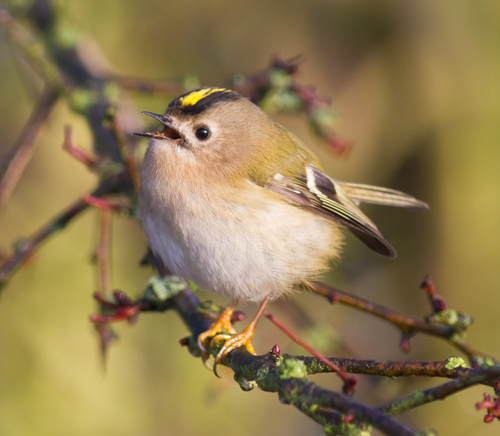
Goldcrest
The Goldcrest (*Regulus regulus*) is one of the smallest birds in Europe, renowned for its vibrant golden crown stripe. This tiny bird plays a significant role in controlling insect populations within its woodland habitats. Despite its diminutive size, the Goldcrest is incredibly resilient, capable of surviving harsh winters in coniferous forests. It holds a place in European folklore, often symbolizing resilience and delicate beauty. Its high-pitched calls and constant activity make it a delight to observe for birdwatchers.
8.5-9.5 cm
Length
13.5-15.5 cm
Wingspan
Least Concern
Conservation Status
Distribution
The Goldcrest is widely distributed across Eurasia, from the British Isles and Western Europe, eastwards through Russia to Japan. It is also found in parts of North Africa. It is largely resident, but northern populations may migrate south for winter.
Lifespan
Typically 2 years in the wild, although some individuals may live longer.
Goldcrest's Habitat
Habitat Types
Coniferous forests, Mixed woodlands, Parks and gardens with mature conifers
Climate Zones
Temperate, Boreal
Adaptations
Goldcrests have dense plumage and a high metabolic rate, allowing them to maintain body temperature in cold climates. Their small size allows them to forage on thin branches and needles, accessing food sources unavailable to larger birds.
Variations
Numerous subspecies have been described, differing slightly in plumage coloration and size across their vast range. For example, island populations, such as those in the Azores, are often recognized as distinct subspecies.
Appearance
Breeding Plumage
Plumage remains relatively consistent throughout the year.
Seasonal Feather Changes
Minimal seasonal variation.
Sex Based Plumage Differences
Males have a bright orange central crown stripe bordered with black, while females have a yellow stripe. Juveniles lack the bright crown stripe.
Notable Features
Bright golden crown stripe (orange in males, yellow in females), Black eye stripe, Olive-green upperparts, Pale underparts
Diet and Feeding
Primary Foods
Small insects, Spiders, Insect eggs and larvae
Foraging Behavior
Goldcrests are constantly active, flitting through foliage and gleaning insects from leaves and branches. They often hover briefly to pick insects from the undersides of leaves. They are known to forage at all levels of the forest, from the canopy to the understory.
Specializations
Their fine, pointed beaks are perfectly adapted for picking tiny invertebrates from crevices and between conifer needles.
Seasonal Diet Variations
During winter, when insects are scarcer, they may also consume small seeds and may join mixed-species flocks to improve foraging efficiency.
Behavior
Social Structure
Generally solitary or in pairs during the breeding season. Outside the breeding season, they may form small family groups or join mixed-species flocks, particularly with tits.
Communication
High-pitched 'see-see-see' calls, A thin, wavering song, Visual displays, such as raising the crown feathers
Migration
While many populations are resident, northern and eastern populations undertake partial or complete migrations southwards for the winter. The extent of migration varies depending on the severity of the winter.
Territorial or Group Behaviors
Males are territorial during the breeding season, defending their nesting area against rivals. Outside of breeding, they are less territorial and may forage in loose flocks.
Conservation
Threats
Habitat loss and fragmentation (particularly loss of mature coniferous forests), Climate change (severe winters can cause high mortality), Pesticide use (reducing insect prey availability)
Protection Programs
General habitat protection measures, Sustainable forestry practices
Local National Laws
Protected under various national and international wildlife legislation, such as the EU Birds Directive.
Population Trend
Stable
Population Estimates
The global population is estimated to be very large, with tens of millions of pairs in Europe alone.
Interesting Facts
They are Europe's smallest bird.
Along with the closely related Firecrest.
They can survive extremely cold temperatures.
Their dense plumage and high metabolic rate allow them to withstand temperatures well below freezing.
They lay a very large number of eggs.
This high reproductive rate helps to offset high mortality rates, especially during harsh winters.
The Goldcrest has a very high-pitched song.
It is so high that some older people can no longer hear it.
Faqs about Goldcrest
What do Goldcrests eat?
Goldcrests primarily eat small insects, spiders, and insect eggs and larvae. They glean these from leaves and branches, often hovering to reach prey on the undersides of leaves.
Where do Goldcrests live?
Goldcrests are found in coniferous and mixed woodlands across Eurasia. They prefer areas with mature trees, especially conifers like spruce and fir.
Are Goldcrests migratory?
Some Goldcrest populations are resident, while others, particularly those in northern and eastern regions, migrate south for the winter. The extent of migration depends on the severity of the winter.
How can I tell a male Goldcrest from a female?
Males have a bright orange central crown stripe, while females have a yellow stripe. Juveniles lack the bright crown stripe altogether.
Copyright @ Nature Style Limited. All Rights Reserved.
 English
English